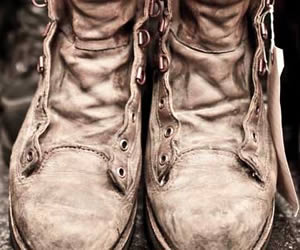 Selecting your hiking boots could be a difficult proposition, because there are so many types of hiking boots available, each with distinct disadvantages and advantages. Some are made for light day hiking, some are made for backpacking with heavy loads on your back, and still others are constructed to endure heavy duty mountaineering. The key to choosing the right boot is knowing what type of hiking you are going to do.
Selecting your hiking boots could be a difficult proposition, because there are so many types of hiking boots available, each with distinct disadvantages and advantages. Some are made for light day hiking, some are made for backpacking with heavy loads on your back, and still others are constructed to endure heavy duty mountaineering. The key to choosing the right boot is knowing what type of hiking you are going to do.
And just because it’s an expensive pair of boots doesn’t mean it’s the right pair of boots. By following these simple tips and instructions you can find a great pair of hiking boots that perform well, and with no surprises once the trail gets tough.
Durability
One consideration in your boot purchase is durability. Hiking can put a strain on any type of footwear, even the sturdiest pair of boots can seem to give way on technical trails, and the worst thing that can happen to you during a hike is the breakdown of your hiking boots. Look for a pair of boots that has decent durability. Basic options are full-grain leather, split-grain leather, and modern polyester and nylon materials.
These construction material all have their advantages:
- Synthetic materials like nylon and polyester have superior drying characteristics and break in easier, but they do wear out quicker.
- Full grain leather is very durable, water resistant, superior resistance to punctures, but they are heavier, more expensive, and often have a longer break-in period.
- Split-leather boots are usually combined with synthetic materials. They are lighter than full-grain leather, and also less expensive, however they don’t have the waterproofing characteristics of full-grain leather.
Boot Style
Yes, hiking boots come in different styles, and choosing the right style is important, e.g., low-cut shoes, mid-cut boots, and high-cut boots.
- Low-cut shoes are generally acceptable for short day hikes without heavy backpack loads. Although they give your feet more freedom and ankle flexibility, they often expose your feet to dirt, mud, limbs, and small rocks. Choose a low-cut boot like this for maintained trail hiking, such as local state park hiking trails.
- Mid-cut boots are generally the boot of choice for shorter multi-day backpacking trip because they offer superior ankle support and are lighter than the high-cut boots, and they provide better protection from rocks and other potential obstacles. They also offer greater support than low-cut shoes do for your backpacking loads.
- High-cut boots are specifically designed for rough mountain trails and off-the-trail backpacking. They provide the greatest ankle support for heavier backpack loads. These boots are also more expensive than the low-cut and mid-cut boots.
Comfort
Comfort becomes obviously more important during longer hikes, because we can all endure a little discomfort for a few hours. Always take the time to try on any pair of hiking boots before purchasing them. I don’t recommend buying boots online, but sometimes you can get a great discount or coupon code that will save you 10% – 25% online. So if you are going to order online be sure to go to a dealer beforehand and try on a new pair. Walk around in them for a while to determine their comfort and support. For an added test, carry a backpack filled with some gear. I recommend at least 30 minutes with the boot on – if the store will permit- yeah, that’s kind of disgusting. The full weight of your backpack will change the boots comfort and stability of the hiking boots performance.
Weather Temperature
Consider the environment temperature that you will be hiking in – this is one of the most miscalculated issues when shopping for hiking boots . You may need a vented pair of hiking boots if hiking in warmer weather, and require very little to no ventilation on cooler days. A friend of mine researched his $200 hiking boots before making the purchase, but when he went hiking in July his feet sweat so bad the boots became loose and he got severe blisters anyhow. Don’t make that mistake, and if you are hiking in different environments you may have to consider more than one pair of boots.
Trip Length
You need to also consider how long and how technical your trips are. You may be able to get away with buying a less expensive pair of boots if your hikes are shorter and less technical. But if you are going on lengthy or technical trips a higher quality boot is necessary.
And like I mentioned earlier, you may be better off to purchase two pairs of lesser expensive medium quality boots that are suitable for different environments rather than purchasing one pair of high quality boots that are only suitable for one environment.
By following these very simple tips you help to ensure a comfortable trip without strain or pain.
Happy Hiking!


No complaints on this end, smpily a good piece.